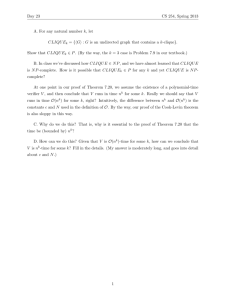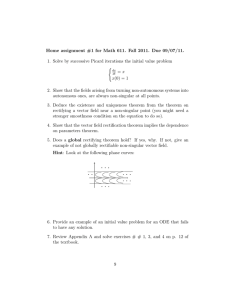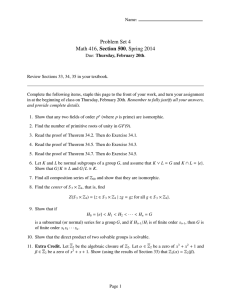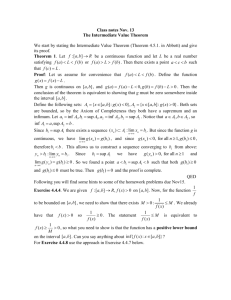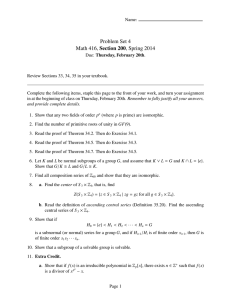L Minimization for Plants with Commensurate delays
advertisement
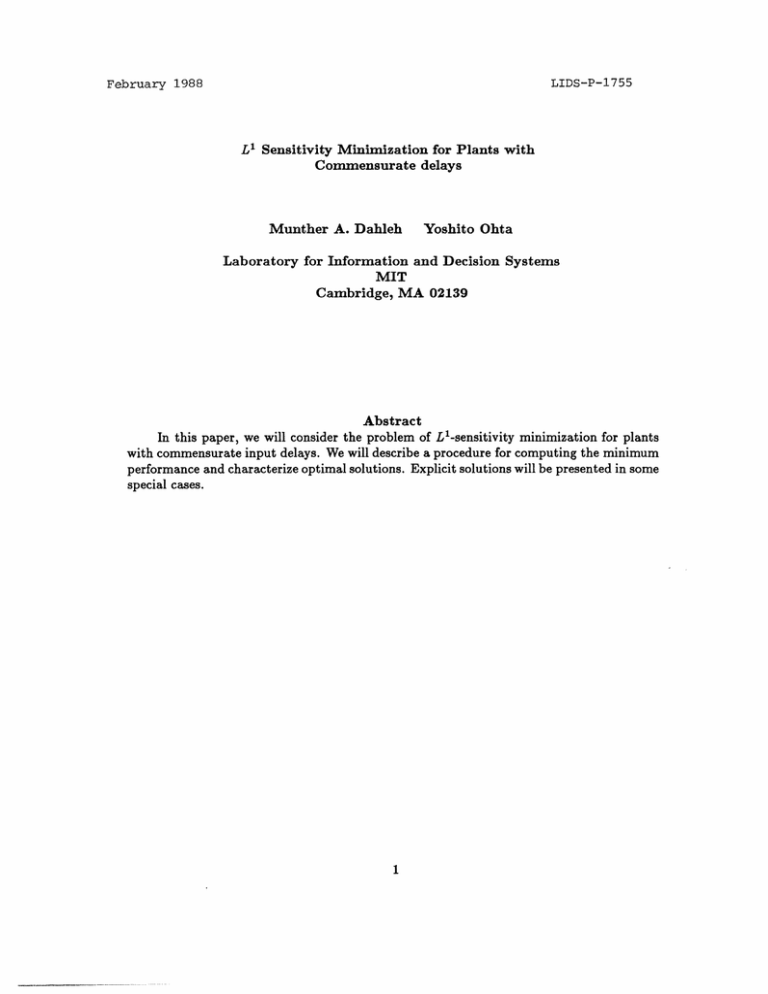
LIDS-P-1755
February 1988
L1 Sensitivity Minimization for Plants with
Commensurate delays
Munther A. Dahleh
Yoshito Ohta
Laboratory for Information and Decision Systems
MIT
Cambridge, MA 02139
Abstract
In this paper, we will consider the problem of Ll-sensitivity minimization for plants
with commensurate input delays. We will describe a procedure for computing the minimum
performance and characterize optimal solutions. Explicit solutions will be presented in some
special cases.
Notation
X*
BS
S'
Dual space of a normed linear space X
all elements in S with norm < 1
the annihilator subspace defined as
{X* E X* I < s,x* >= OVs
iS
E
S C X}
the annihilator subspace defined as
{z E XI < x, 8 >= OVs E S c X*}
R+
the positive real line [0, oo)
LP(R+)
classical Banach spaces on R+
BV(X)
functions of bounded variation on X
Co (X)
continuous function on a locally compact spaceX such that
Ve >
0,
{x E
XIIf(x)I > e} is compact
1. Introduction
The problem of L1 -sensitivity minimization in the case of an arbitrary rational plant
with a pure input delay was considered in [3] where the problem was shown to be equivalent
to the rational plant case solved in [2]. In this paper, we consider plants of the form P = UPo
where Po has a stable inverse, and U is a polynomial of delays. The method of solution
is quite different from the one presented in [3] for the case of pure delay, which cannot be
generalized.
The interest in this problem stems from the fact that many systems have delays in
various parts of the control loop. Even though one might not want to build an optimal
controller based on modeling these delays, it is crucial to identify the limitations of design
within such an environment. The theory in this paper provides such information. It mimics
in spirit similar results reported in the Hco problem such as [4],[5],[8].
2. Mathematical Preliminaries
In this paper will follow the notation introduced in [2]. Let AM denoted the space of
all atomic measures of bounded variation on R+, i.e,
00
hi(t - ti), {hi} E 11 ,ti > 0
AM = {hlh(t) =
i=O
with norm defined as
00
hi0
IIhIIAM =E
i=O
Let A = AM ® L'(R+). Then A consists of all distributions of the form
h(t) = hAM(t) + hM(t)
where hAM E AM and hM E L'(R+). The norm on A is defined as
i|hJlA
=
IIhAMIIAM + I|hMIIL(R+)-
We will denote by A the space of Laplace transform of distributions in A with the
same norm. It is well known that A is a Banach algebra and defines a set of BIBO-stable,
linear, time-invariant impulse responses with the given operator norm. For the rest of this
paper, H will denote the Laplace transform of h, i.e. H E A and h E A.
It can be shown that A can be embedded in the space of function of bounded variation
BV(R+), (This embedding is not a surjection). This injection is done in the obvious way
h--
=
h
h(r)dr
and we have
lihil = TV(h) = Total Variation of h
We will use this notation for the rest of the paper. Denote by Co(R+) the space of all
continuous function that converge to zero at infinity, with norm
1ll1100 = sup Iz(t)I
It is well known [1], that
Co*(X) = BV(X)
for any locally convex linear space X, i.e. for every F bounded linear functional on Co (X),
there exists a function f E BV(X) such that
/00
F(x) =
with
IlFI- = TV(f).
x(t)df(t)
In the case of X = R+ and df = fdt with f E A, we denote the above
operation as < x, f >.
3. Problem Definition
Let the plant be given by
P = UPo
where Pol'E A and
N
U =
E
une-
(6n),
n=O
3
UN
0O
The problem is to minimize the weighted sensitivity function over all stabilizing compensators. The problem is equivalent to [2]
Ho
= inf 11W - UQ11A
(OPT)
QEA
Without loss of generality, we will assume that the polynomial
N
U(Z) = E
Un Z
n=O
has all its zeros inside the open unit disc D. The factors with zeros outside the unit disc
are invertible in A and can be lumped in Q. Also, we will assume that W is a strictly
proper, stable rational function. Even though this assumption is not necessary, it makes
the presentation more transparent.
4. Problem Solution:
Let the subspace S c A be defined as
S = (k
E
Alk = u * q, q E A}
The following theorem characterizes LS.
Theorem 1
N
s
=
ui f(t + 8i) = }
{f E Co(R+)l
i=O
Proof:
Let f E 'S,
then < f,k >= 0 V k E S. However
No
< f,k>=
>
N
of(t),usq(t -
i)dt
i=o0
N
:
oo
uio
i=O
N
=
EIuif
f(t)q(t- Ui)dt
oo
f (t + ei)q(t)dt = 0
i=O
N
,E
ui f(t + Si) =
i=O
Q.E.D
Consider ['S]L. Then, from [7], ['S]' = weak*-closure of S = S
w,= fot w(t)dt and consider the problem:
1i = min TV(i - k)
c BV(R+). Let
(OPT1)
iESg
The above problem (OPT1) will be trivially equivalent to (OPT) if St = S. This not
necessarily the case, however by considering the dual problems, we will verify that Al = p0
and hence (OPT1) is equivalent to (OPT). Dualizing (OPT1) [6], we get
min TV(ti-
k) =
kES.
sup
f(t)dt~i(t)
fEBkS
=
sup
fEB1 S
< f, w >
To compute the above problem, we will find explicit representation of f E iS. The one
parameter family of difference equation characterizing 'S gives rise to a stable semi-group
by which all elements in I S can be generated given any initial vector ((r), r E [0, 6). Define
a subspace M inside CN [0, 6) such that ~ E CN [0, 6) if
lim (i-l(t)=Ci(0), i = 2,..., N
t-+6
N--
~t--*6UN
Then the following theorem is true.
Theorem 2:
f E 'S if and only if there exists a vector e(r) E M such that
f(r + 6i) = lT(i) (r)
f
F=
r E [0,6), i = 0,1,2,...
(i) = e l F t
0
1
0
...
O
O
0
1
...
0O
...
...
...
.
-U0/UN
.
*
*-..
el = (1, 0,o ... 0)
-Un-I /UN
Proof
From Theorem 1, f E ±S if and only if:
N-1
f(t + 6N)
f (t + n)
= n=
5
UN
Let t = r +
i,
E (O,6), i= 0, 1, 2,... and define:
xl(i) = f (r + Si)
X2(i) =f(r
+ 8(i+ 1))
ZN (i) = f(r + 6(i + N - 1))
Let
(i)(i)
then
X,r(i + 1) = FXr(i)
Hence,
f(r)
f(r+ 6)
x:(k) = Fkzx(0)= F
f(a + 6(N - 1))
Finally, we note that f is completely characterized from its values on the interval [0, SN).
This completes the proof. Note that
f(t + Si) = el Fk(O)
Q.E.D
To abbreviate the notation, we will denote the association of a vector C with f by the
linear map T, i.e.
T : M - Co(R+).
Now we go back to the dual problem for the evaluation of /l.
adjoint of T defined as a map:
T*: BV(R+) - M*
Let T* denote the
It is straight forward to verify that T* maps A into A with support [0, 5), in particular:
o00
T*w(r) = E w(r + i)3(i)
i=O
The dual problem is given by
sup < T*w, ~ >
IlT1ll00 <1
6
r E [0, 6)
eEM
Note that IITl11oo < 1 if and only if
I/p(i)C(r)- < 1 r E [0, 6) i = o, 12, ...
Since pT(i) = elF i with (el, F) observable and F1 has eigenvalues inside the disc (i.e. a
stable semi-group), then there exists an integer I such that
[ITClloo < 1 4
I#T(i)(T)l'<l VrE [0,6),
i = 0,1,...,I
A lower bound of the integer I can be easily derived. Next, we will show that the dual
problem can be solved by solving a linear programming problem for each t E [0, 6).
Theorem 3
itdt
Al=
where
it = max ZTT*w(t)
I/ ' (i)X I < 1
x E RN
i = O, ... ,I
Proof:
supJ CT(t)(T'w)(t)dt <
<
sup(t)l(T(t)T*w(t)ldt
j
tdt
Denote by xt, the solution achieving Pt. Since T*w is a continuous function of t (w is
rational and strictly proper), there exists a continuous function C(t) E M that approximates
the solution arbitrarily closely. The details are standard and hence, omitted.
Remark 1:
The dual of (OPT) yield a similar problem with C(r) E LN [0,6). By solving the
problem pointwise we get the same xt and hence p0o = pl. This shows that (OPT) is
equivalent to (OPT1).
The previous theorem enables us to compute the optimal value po by computing an
infinite number of linear programming problems. However, we note that the constraint set
is the same in all of these problems. Since F is a stable matrix and (el, F) observable, the
constraint set is given by
Cg = {x E RNj6T(i)
---;
b I~~~~~
-
-
~
~
< 1, i = 0,
-
-
I}
. ..
-
-~
is a bounded polygon. Let xl,..., pxbe the extreme points of Cal. Define subsets I+(j), I_ (j)l
of {0, 1,..., I) such that k E I+(j) if and only if PT(k)xj = 1, and k E I_(j) if and only if
#T(k)xj = -1, for j = 1,... ,p. Let Py be the convex cone generated by {f(k)Ik E I+(j)}u
{-3(k) k E I_ (j) (note that Pj is a N-dimensional cone) and let I(j) = I+(j) U I_ (j). In
the next Lemma, we will show that if the vector T*w(t) at some fixed t, lies in the cone Pj,
then the solution in Theorem 3 is given by xj. Hence, to solve the problem in Theorem 3,
we first compute T*w(t) for all t E [0, 6), which is easily done since W is rational. Then we
project this vector on the p different convex cones Pj. xj will be the maximizing solution
in the interval where the vector T*w(t) lies in the Pj cone. This lemma is true in the
generic case of nondegenerate problems, and corresponds to results already known in linear
programming problems.
Lemma
max xTy = XjT
xEC B
if and only if y E Pi corresponding to zj.
Proof
If y E Pj, then y = >iEI(j) aifl(i), ai > 0 for i E I+, ai < 0 for i E I (j).
Therefore, for any x E Ca,, we have:
YTX _ yTZ
X =
ai(PT(i)ZXj-PT(i)X)
aI (1 -_ 6T (i)XI)
>
>0
It is well known that the above maximization problem is always achieved at an extreme
point. To prove the converse of this theorem, we will show that if y does not belong to
the cone Pj then there exists an x E C7 in any neighborhood of xj such that xTy > xjTy.
Hence y must belong to at least one cone. Let y = EEI(j) ai l(i)
where ak < 0 for some
1
k E I+(j). Choose an x E C6 in such a way that PT(i)X = 1 for i E I+(j), i 0 k,
T (i)X= -1 for i E I_ (j) and /T (k)x < 1. The existence of such a vector is possible if the
problem is nondegenerate, i.e fl(i), i E I(j) are linearly independent. Then we have
XTy =
=
aPT(i)Z
Z
>
lail + akfT(k)x
laii +ak
j•k
= XjTy
which completes the proof.
8
Once the extreme points are calculated, the indices I(j) are easily determined. Expressing the vector T*w(t) as a linear combination of the vectors spanning the convex cones
involves solving p systems of linear equations (generically). Then the coefficients a(t) (as
in the proof) determine exactly the maximizing solution. This procedure has the advantage of evaluating the infinitely many linear programming problems by a finite number of
inversion problems followed by signature functions. For delay polynomials of low order,
this procedure is quite attractive. For high order polynomials, the problem is computationally complex. Later on, we will present examples of special cases where these linear
programming problems reduce tremendously.
Remark 2:
Recall that we have considered the enlarged problem (OPT1). By following this approach, we avoid looking for a solution to the primal problem inside (LOO)*. This way we
guarantee existence inside S"'. The following theorem characterizes these solutions.
Theorem 4
A solution b E BV(R+) of the problem:
= min TV (i - k)
kES*
exists and satisfies the following:
1. T*+ = T*wi
2. ~ is aligned with Te
3. TV(+) = po
Proof
The proof is a restatement of the alignment conditions [6] and the fact that 0-ti
E SW.
5. Examples
In this section we will present three examples that represent important special cases
of the theory, and provide complete solution for every case.
Example I:
U() = e-86
then
T = identity embedding map
T* = II = projection onto [0, 6)
Optimal solution
= I 16w.
Example II:
U(s) = u 0 + Ule8
Define
b = -uo/ul E D
9
6
Then
(i) = b'
T*w = Eb'tw(t+i6) = wl(t)
i=O
/to=
sup
<wl,
Ibi 6(t)ll
>=
sup
<
1,
>
le(t) _l1
= IIW1111
The optimal solution is given by
wl
t E [0,6)
9=lO
tE[O,6)t[,
oo)
Example III: Let
1
s+ a
then
00
i=0 ea'tea-"'i(i)
T'w(t) =
e -=at E
-a
6
tE[0, 5)
iX(i)
i=O
= e-atQo
Thus
/it = -e
t
max xTako
leiF'zl < 1
i = 0, 1, 2,..., I
and
t =
e-at
XOTCO
for some xo. Hence, po is given by
(1-
11
e-a6)zoTao
An optimal 0 can be constructed to satisfy Theorem 4. We note that the above maximization problem is the dual of:
t
=
e-at max Z ii
i=O
10
Eqi=0 (i) =t
i=O
In fact, the optimal qi : 0 only when IpT(i)xol = 1. Let 4 ° be an optimal solution and
define the function +(t) as:
X(t + 6i)=
0{e-t
0
i < I, t Er[0, 6)
otherwise
It is straightforward to verify that ~ satisfies the conditions of Theorem 4, and hence an
optimal solution.
Conclusions
In this paper, we present a solution to the L 1 minimization problem for plants with
commensurate delays. In the special case where the weight has one pole, the problem can
be solved by a single linear programming problem. Other special cases were also presented.
A method for computing the optimal performance and a characterization of minimizing
solutions are given. Issues such as computational complexity, and existence of solutions in
the algebra A will not be discussed in this paper.
~ ----
~11
· ------------·-------
References
J.B. Conway. "A course in functional analysis," Springer-Verlag, 1985.
[1]
M.A. Dahleh and J.B. Pearson. "L 1 optimal feedback compensators for continuous-time
systems," IEEE Trans. A-C, Vol AC-32, October 1987.
[2]
[3] M.A. Dahleh. "L1 optimal controllers for plants with pure input delay," 1988 CISS, Princeton, N.J.
[4]
D.S. Flamm and S.K. Mitter, "Progress on Hoo optimal sensitivity for delay systems,"
Tech. Rept. LIDS-P-1513, MIT, Cambridge, MA.
[5]
C. Foias, A. Tannenbaum and G. Zames, "Weighted sensitivity minimization for delay
systems," XSIAM J. Control and Opt., To appear.
[6]
D.G. Luenberger. Optimization by Vector Space Methods, John Wiley and Sons, Inc, N.Y,
1969.
[7]
W. Rudin. Functional Analysis, McGraw-Hill, Inc., 1973.
[8]
G. Tadmor. " An interpolation problem associated with H°°-optimal design in systems
with distributed input lags," Systems and Control Letters 8, 1987.
This research was supported by the Army Research Office, Center for Intelligent
Control Systems, under grant ARO DAAL03-86-K-0171.
12


